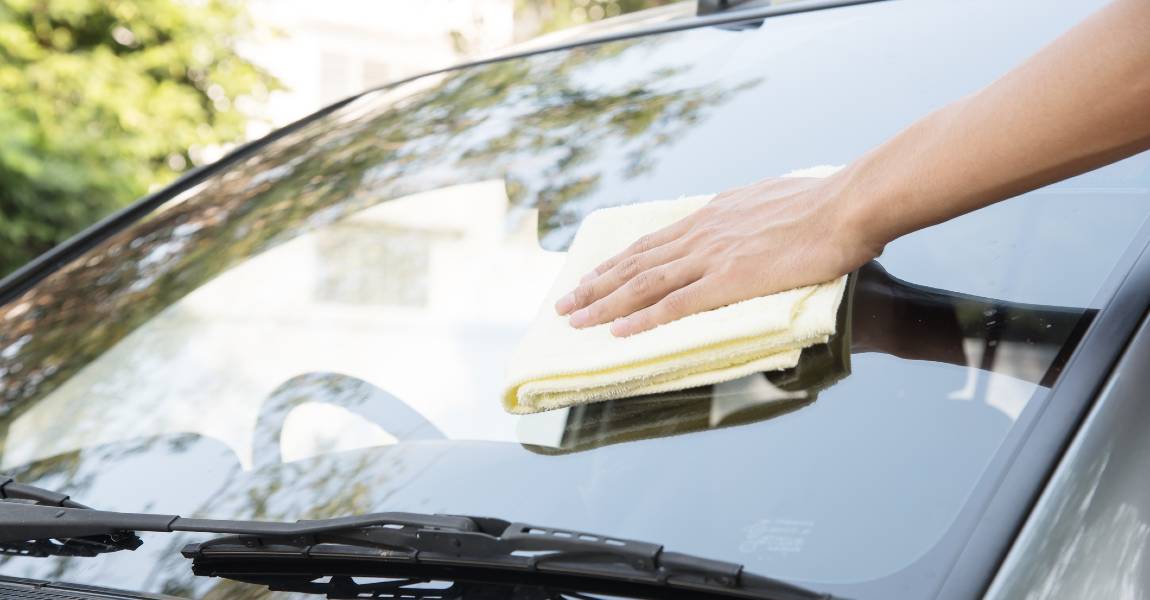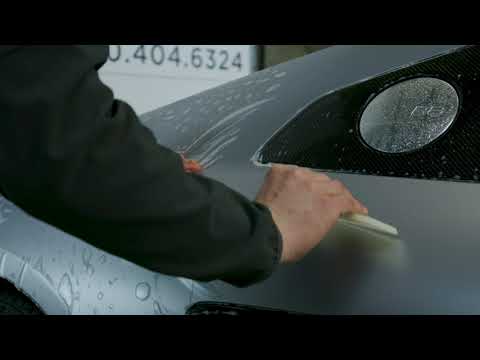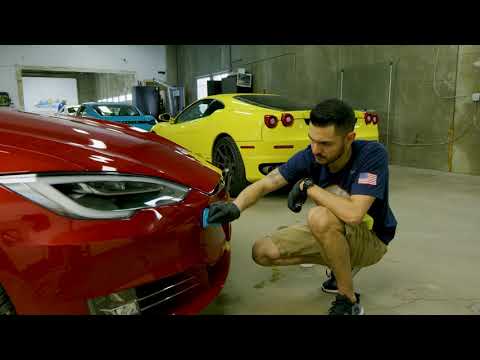Car window tinting can add a sleek and stylish look to your vehicle while also providing privacy and reducing heat and glare. However, to keep your tint looking new and functioning properly, proper maintenance is key.
“Tinting your windows can provide security and privacy for drivers and passengers. According to a survey by the International Window Film Association, 57% of car owners who tint their windows do so for privacy reasons”.
Window tinting is a great investment for any vehicle owner, but ensuring it lasts as long as possible is important. By following these car window tinting maintenance tips, you can keep your tint looking new and functioning properly for years to come.
From avoiding harsh chemicals to cleaning with the right tools and techniques, this blog post will provide you with everything you need to know to properly maintain your car window tinting.

- What is Car Window Tinting?
- What are the Benefits of Car Window Tinting Maintenance?
- Car Window Tinting Maintenance: What Tools and Materials are Needed?
- Preparing Your Vehicle for Window Tint Maintenance
- What Should I Avoid with Auto Window Tinting?
- Should I Wax My Car Windows to Maintain the Tinting Film?
- Conclusion
What is Car Window Tinting?
Car window tinting is the process of Applying a thin film to the windows of a vehicle to reduce the amount of sunlight and heat that enters the car. This film is typically made of polyester or other synthetic materials and comes in various shades of darkness. Car window tinting is a popular aftermarket modification that can improve the aesthetics and functionality of a vehicle.
According to a survey conducted by the International Window Film Association, the top reasons people choose to tint their car windows are to reduce heat and glare, protect the interior of the vehicle, and improve privacy. In fact, the same survey found that 54% of respondents tinted their vehicle’s windows for heat reduction, while 45% did so for glare reduction and 38% for privacy.
Other benefits of car tinting include:
- UV protection: Tinting can block up to 99% of harmful UV rays, which can cause skin damage or even skin cancer and fade the interior of a vehicle over time.
- Improved safety: In the event of an accident, window tinting can help prevent shattered glass from flying into the car, reducing the risk of injury.
- Energy savings: By reducing the amount of heat that enters the car, window tinting can help improve fuel efficiency and reduce the need for air conditioning.
Car window tinting is legal in most states, but each state has its own regulations regarding the darkness of the tint and where it can be applied to the vehicle. It’s important to check local window tint laws before getting your car windows tinted to avoid any legal issues.
Overall, tinting can be a valuable investment for those looking to improve their vehicle’s comfort, safety, and privacy.
“According to a survey conducted by the International Window Film Association, the demand for car window tinting has increased by 7% annually over the past few years. The same survey found that 86% of car owners who tint their windows do so to reduce heat and glare from the sun”.
What are the Benefits of Car Window Tinting Maintenance?
Tinting Maintenance is crucial for keeping your car’s windows looking great and functioning correctly. There are several benefits to maintaining your car’s window tint, including increased privacy, protection from UV rays and improved energy efficiency. However, there are also some potential drawbacks to consider, such as the cost of maintenance and the risk of damage to the tinting film.
One of the main benefits of car window tinting maintenance is increased privacy. Tinted windows can help to keep prying eyes from looking inside your car, which can be especially helpful if you frequently park in public places.
Additionally, quality tints can help reduce glare from the sun and headlights at night, making it easier to see while driving.
Another benefit of car window tinting maintenance is protection from UV rays. Tinted windows can block up to 99% of harmful UV rays, which can help to prevent skin damage and fading of your car’s interior.
“In a study conducted by the American Skin Cancer Foundation, it was found that car windows only block about 53% of harmful UV rays, while window tinting can block up to 99% of UV rays”.
Additionally, window film tints can help keep your car cooler in the summer months, reducing the need for air conditioning and improving energy efficiency.
However, there are also some potential drawbacks to consider regarding car window tinting maintenance. For example, maintaining tinted windows can be costly, as you may need to replace the tinting film if it becomes damaged or worn.
Additionally, there is a risk of damage to the tinting film if it is not properly maintained, such as if it is scratched or scraped.
Finally, some states have laws regarding the level of tint that is allowed on car windows, so it is essential to check with your local regulations before installing or maintaining window tinting.
Pros:
- Increased privacy
- Protection from UV rays
- Improved energy efficiency
Cons:
- Cost of maintenance
- Risk of damage to tinting film
- Laws regarding tint level in some states

Car Window Tinting Maintenance: What Tools and Materials are Needed?
Car window tinting can be a great investment for any vehicle owner. Not only does it add a sleek and stylish look, but it also provides increased privacy and protection from harmful UV rays. However, like any other aspect of a car, it requires proper maintenance to keep it looking and performing its best.
Here are the tools and materials needed for car window tinting maintenance:
1. Soft Microfiber Cloth Towel: These microfiber towels are essential for cleaning and maintaining tinted windows. They are gentle on the surface and do not leave any scratches or residue.
2. Ammonia-Free Glass Cleaner: A high-quality glass cleaner is necessary for removing dirt, grime and fingerprints from tinted windows. It is essential to avoid using ammonia-based cleaners as they can damage the tint.
3. Plastic Razor Blade: A plastic razor blade is a valuable tool for removing stubborn debris and residue from tinted car windows. Using a plastic blade instead of a metal one is important to avoid scratching the surface.
4. Soft-bristled Brush: A soft-bristled brush can be used to remove dirt and debris from the edges and corners.
5. Tint Safe Cleaner: This specialized cleaner is designed to clean and maintain window tint. It is formulated to be gentle on the tint and contains no harsh chemicals that can damage it.
6. Water: Plain clean water can also be used for cleaning the tinted windows. However, it is important to use distilled water to avoid leaving mineral deposits on the surface.
7. Protective Film: A protective film can be applied to tinted windows to protect them from scratches, chips, and other types of damage. It is essential to choose a film that is specifically designed for window tinting.
Using these tools and materials, car owners can ensure that their window tint films remain clean, clear, and protected.
Regular maintenance can extend the life of the tint and keep it looking great for years to come.
Some Common Items required:
- soft cloth and microfiber towels
- paper towels
- warm water
- spray bottle
- cleaning product
- cleaning solution
- clean microfiber cloth
- cotton cloth
- dry microfiber cloth
- soft sponge
- window tint care
- cloth with water
- clean rubber squeegee
Preparing Your Vehicle for Window Tint Maintenance
Preparing your vehicle for window tint maintenance is essential in ensuring the longevity and quality of your window tinting. Auto glass technicians who provide window tinting services recommend that you follow proper window tint care instructions to avoid damaging the tint and the glass surface.
It is essential to avoid using harsh chemicals or abrasive cleaning tools on the glass surface of your windows. Instead, opt for a mild soap and water solution and use a soft cloth or sponge.
Additionally, avoid rolling down your windows for at least 48 hours after the tint application to prevent air bubbles from forming.
A critical aspect of proper tint Maintenance is using the correct application tools and techniques to prevent air bubbles from forming under the tint. Air bubbles look unsightly and can cause the tint to peel off over time, leaving your car’s windows unprotected.
To prepare your vehicle for window tint maintenance, thoroughly clean the glass surface to remove any dirt, dust or debris that may have accumulated. Use a soft, lint-free cloth to wipe the glass surface, and avoid using any abrasive cleaners or tools that can scratch the glass.
Once the glass surface is clean. Inspect it for any scratches or chips that may have occurred during installation or from regular wear and tear.
If you notice any damage, take your vehicle to a window tinting shop or an auto glass technician for repair before proceeding with maintenance.
Next, ensure you have the correct application tools, such as a squeegee, spray bottle, and razor blade, to remove any air bubbles that may have formed under the tint.
Poor-quality tools can lead to uneven tint application and air bubbles, compromising the integrity of the tinted film.
Follow the window tint care instructions provided by your auto glass technician or window tinting shop to ensure you’re using the proper techniques and products for your specific type of tint. By preparing your vehicle for window tint maintenance properly, you can ensure that your tint remains in great condition for years to come.
Read our guide to learn more about Auto Window Tinting: Brands, Laws, Types, Benefits, and Installation Tips

Park in Direct Sunlight to Assess Damage/Soiling
Parking a car in direct sunlight is an effective way to assess damage and soiling on car window tint. Any imperfections or damages on the tinted film will become more visible when exposed to sunlight. This is because sunlight can highlight scratches, window tint bubbles or peels on the tint.
Additionally, sunlight can make dirt or grime on the tint more noticeable. Parking the car in direct sunlight. Car owners can quickly identify any issues with their window tint and take appropriate action to repair or replace it.
However, it is important to note that constant sunlight exposure can also cause damage to the tint itself, so car owners should take care not to leave their cars parked in the sun for extended periods.
Remove Bird Droppings with a Clean Microfiber Cloth and Glass Cleaner
Removing bird droppings from tinted car windows can be a delicate process, but it can be done effectively with the right tools and techniques.
- Start by spraying the affected area with a glass cleaner that is safe for use on tinted windows.
- Allow the cleaner to sit for a few minutes to loosen the droppings.
- Next, take a clean microfiber cloth and gently wipe away the droppings in a circular motion.
- Avoid using too much pressure or abrasive materials that could scratch the tinted surface.
- If the droppings are particularly stubborn, you may need to repeat the process or use a specialized bird-dropping remover.
- Once the droppings are removed, dry and polish the area to a streak-free shine with a clean microfiber cloth.
- Regularly cleaning bird droppings from tinted car windows can help prevent damage and maintain the appearance of your vehicle.
Wash Windows with Warm Water and Soft Cloth or Paper Towel
1. First, gather all the necessary materials, including warm water, a soft cloth or paper towel, and a bucket if needed.
2. Fill the bucket with warm water and make sure it is not too hot, as hot water can damage the tint on the windows.
3. Dip the soft cloth or paper towel into the warm water and wring out any excess water so that it is damp but not dripping wet.
4. Starting from the top and, gently wipe the tinted surface vertically to remove any dirt or grime.
5. Use a clean section of the cloth or paper towel for each swipe to avoid spreading dirt and debris around.
6. If there are any stubborn spots or stains, use a gentle cleaner designed explicitly for tinted windows and apply it to the affected area with a soft cloth or paper towel.
7. Rinse the glass surface with clean warm water to remove any soap or cleaner residue.
8. Dry the glass with a clean cloth or paper towel to avoid water spots.
9. Repeat the process for each window on the car until all the tinted surfaces are clean and free of dirt and debris.
10. Finally, properly dispose of any used materials and enjoy the clean and clear view through your freshly washed tinted windows.

What Should I Avoid with Auto Window Tinting?
Auto window tinting is a popular way to improve the appearance and functionality of your vehicle, but there are some things you should avoid to ensure that the process is successful, and you don’t damage your car.
Firstly, avoid using low-quality tinting materials or attempting to tint your windows yourself is important. Poor quality tinting can result in a range of problems, including bubbling, peeling, and discoloration, which can be challenging to fix and ultimately reduce the lifespan of your tinting.
Similarly, DIY tinting can be challenging to get right, resulting in uneven coverage or damage to your windows, which can be costly to repair.
Another thing to avoid when it comes to auto window tinting is choosing a tinting shade that is too dark for your vehicle. While you may be tempted to choose the darkest tint possible for privacy or style reasons, it’s important to remember that this can be illegal in some states and can also be dangerous on the road. Dark tints can reduce visibility, particularly at night or in low-light conditions, increasing the risk of accidents.
Additionally, dark tints can make it difficult for law enforcement officers to see into your vehicle, which can be a safety concern in certain situations.
To avoid these problems, it’s crucial to choose a tinting shade that is within the legal limits in your state, and that provides adequate visibility and safety on the road.
Other things to avoid with auto window tint include:
- Choosing a tinting material that is incompatible with your car’s windows or climate conditions
- Applying tinting to dirty or damaged windows
- Cleaning tinted windshields and glass with abrasive products, abrasive tools, or ammonia-based products
- Steam Cleaning and razor blades
- Rolling down windows before the tinting has fully cured
- Ignoring any signs of damage or wear on your tinting, as this can reduce its effectiveness and lifespan.
Should I Wax My Car Windows to Maintain the Tinting Film?
Waxing car windows is a common practice among car enthusiasts to maintain the shine and cleanliness of their car’s exterior. However, many people wonder if waxing the windows is safe and beneficial when it comes to cars with window tinting film.
Here are some pros and cons to consider before deciding whether to wax your car windows with tinting film:
Pros:
1. Protection: Waxing your car windows can provide extra protection against environmental factors like rain, snow, and UV rays. This can help prolong the life of your window tinting film and keep it looking new for longer.
2. Easy Cleaning: Waxing can make cleaning your car windows easier by repelling dirt and water. This can save you time and effort in maintaining your car’s appearance.
3. Enhanced Appearance: Waxing can add a glossy shine to your car’s windows, enhancing its overall appearance and making it stand out on the road.
Cons:
1. Damage to Tinting Film: Waxing your car windows with tinting film can potentially cause damage if not done correctly. The wax can seep into the edges of the film and cause it to peel or bubble, which can ruin the appearance of your car’s windows.
2. Voided Warranty: Some tinting film manufacturer may void the warranty if the windows are waxed or treated with other chemicals. This can leave you with costly repairs if the film needs to be replaced.
3. Safety Concerns: Waxing your car windows can make them more slippery, reducing visibility and posing a safety hazard while driving.
Key Takeaways:
- Waxing your car windows with tinting film can provide additional protection, make cleaning easier, and enhance appearance.
- However, it can also potentially cause damage, void warranties, and pose safety concerns.
- If you choose to wax, use a non-abrasive wax and avoid getting it on the edges of the tinting film.
- It’s always best to consult a professional or the manufacturer before applying any chemicals or treatments to your car that has tinting film.
Conclusion
In conclusion, maintaining your car window tint is crucial to keeping it looking new and protecting the investment you made in it.
By following the maintenance tips outlined in this article, you can ensure that your tint lasts for years to come and continues to provide you with the benefits you desire.
So, if you haven’t already, take the time to properly care for your window tint and enjoy its many benefits.
Don’t forget to schedule regular inspections and touch-ups with a professional tinting service to keep your tint looking its best. Start taking care of your car window tint today and enjoy the many benefits it provides! Contact us today.




